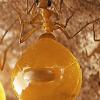Scientific Name: Forelius pruinosus
Common Name:
Distribution: United States, Mexico, Caribbean and possibly South America.
Queen size: 5-6 mm
Worker size: 2.5 mm
Natural Habitat: Lower elevation mountains, Arid-land, sand dunes, river beds and out in the eastern California deserts.
They tend to live anywhere hot and dry that has open space that gets a lot of sun. They commonly nest under rocks.
Circadian Activity: Diurnal
They completely disappear most nights. Very rarely have I seen them active at night.
Mating Flight: Unknown.
I have, however seen alates in the summer months. And I have seen them bud out their colonies in August, so I assume that is their main "flights". They do not from what I have seen, ever fly like most ants.
Queen Founding Method: From what I have seen, they take some workers and make a new nest that is then connected to the main colony.
Monogyne or Polygyne: Polygyne
Lots of queens. One colony that was disturbed by construction, under a boulder had at least 500+ queens (HUGE piles of living queens), but that must be rare though.
Average time from egg to worker: Egg to worker takes 1 month in 70-80 degree fahrenheit temperatures, and the colonies grow VERY fast (a bit faster or as fast as Solenopsis invicta).
Recommended Temperature: 70+ degree fahrenheit, optimal is 80 degrees fahrenheit.
I personally have seen them on pavement in 120 degree weather, out in the full heat of the desert sun.
Recommended Humidity: Very dry, but access to water.
I misted mine once every 2-3 days, depending on how much they were getting the water.
Preferred Foods: Anything.
The question is actually, what will Forelius pruinosus/mccooki NOT eat? Everything I threw in my colony they devoured. They eat more variety of foods than my Argentine ants and Solenopsis invicta ate.
This species does have a social stomach.
Hibernation Details: Optional. Out in the desert in the Salton Sea (far southeast California), they are active in 40 degree day time temperatures with a VERY cold winter storm Wind (it was sunny still). Near the coast, they tend to disappear. One large colony remained active though near the coast. Then again, Forelius pruinosus/mccooki are actually many species in one, that the ones in the Salton Sea may behave very different and are completely different species than the ones on the coast. However, I never had to hibernate even the coastal ones.
Escape Barrier Methods: Be sure to have a good escape proof barrier. They are FAST and very good climbers.
Difficulty rating: 9/10
Easiest ant species I've ever had, the most active and grew VERY quick. However, because of how fast they grew, the easiness goes from 10/10 to 9/10. I still, however have never had kept such a easy, hardy (almost NOTHING kills them, except mites) ant species since my multiple Forelius colonies. They are easier than Solenopsis invicta, Argentine ants and every other "easy" ant I've had. They require very little maintenance, at least a source of water as they prefer it dry, eat a lot and pretty much take care of themselves. Even though they are fast and good climbers, I still found them very easy.
Also, after a few months in captivity...they adapted really quick and were A LOT less prone to escaping when I opened the lid. They actually became really relaxed and laid back ants.
Bite and/or Sting rating: No sting or bite.
Special Care or Interesting Notes: A bit of space for when they grow, since they grow really fast.
They also make amazing looking trails. Long, thick, fast moving trails. With a bit of a mound as well for their nest entrance if you are using substrate. Also, they WILL produce alates and breed in captivity. They also seem to make "supercolonies", as mine had queens in all 6 containers I had connected up. Also the colony I got them from, had WAY over 500 queens under a boulder pulled up from construction. They even managed to drive out the Argentine ants till bulldozers came. Their colony was spread over a HUGE area.
Another colony in the Salton Sea is also really huge, with over 100 queens and in a large area.
Additional Links:
http://www.antweb.or...ecies=pruinosus
http://www.antwiki.o...elius_pruinosus
http://www.tightloop...ants/forpru.htm
http://en.wikipedia....elius_pruinosus
Information submitted by Vendayn
- Formiculture.com
- Forums
- Gallery
- Members
- Member Map
- Chat




















